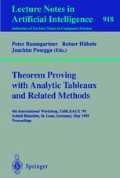Abstract
If E is a set of equations and s and t are terms, then a rigid E-unifier for s and t is a substitution σ such that Eσ“=sσ≐tσ, where any free variables are treated as constants, they are not implicitly quantified.
In [4] it is shown that for a finite set E and terms s and t it is decidable whether or not there is a rigid E-unifier for s and t. However, the proof is complex and concepts like unfailing completion and term orderings play a dominant role. In the present paper a simpler method and proof are given.
Preview
Unable to display preview. Download preview PDF.
References
G. Becher, U. Petermann: ‘Rigid Unification by Completion and Paramodulation'. In B. Nebel, L. Dreschler-Fischer (Eds.): ‘KI-94: Advances in Artificial Intelligence'. Lecture Notes in Artificial Intelligence 861, Springer (1994), pp.319–330.
B. Beckert: ‘Ein vervollständigungsbasiertes Verfahren zur Behandlung von Gleichheit in Tableaukalkül mit freien Variablen'. Master's Thesis Karlsruhe (TH) (1993), in German.
M. Fitting: ‘First-Order Logic and Automated Theorem Proving'. Springer Verlag (1990).
J.H. Gallier, P. Nerendran, S. Raatz, W. Snyder: ‘Theorem Proving Using Equational Matings and Rigid E-Unification'. Journal of the ACM 39(2) (1992), pp. 377–429.
J. Goubault: ‘Rigid E-Unifiability is DEXPTIME-Complete'. Proceedings of the Ninth Annual Symposium on Logic in Computer Science, IEEE Computer Society Press (1994).
J. Goubault: ‘A Rule-Based Algorithm for Rigid E-Unification'. In: ‘3rd Kurt Gödel Colloquium’ 93'. Lecture Notes in Computer Science 713, Springer (1993).
J.W. Lloyd: ‘Foundations of Logic Programming'. Springer, (1984). id., Second, Extended Edition (1987).
W.M.J. Ophelders, H.C.M de Swart: ‘Tableaux versus Resolution; A Comparison'. Fundamenta Informaticae 18 (1993), pp. 109–127.
R.E. Shostak: ‘An Algorithm for Reasoning about Equality', Communications of the ACM 21 (1978), pp. 583–585.
Author information
Authors and Affiliations
Editor information
Rights and permissions
Copyright information
© 1995 Springer-Verlag Berlin Heidelberg
About this paper
Cite this paper
de Kogel, E. (1995). Rigid E-unification simplified. In: Baumgartner, P., Hähnle, R., Possega, J. (eds) Theorem Proving with Analytic Tableaux and Related Methods. TABLEAUX 1995. Lecture Notes in Computer Science, vol 918. Springer, Berlin, Heidelberg. https://doi.org/10.1007/3-540-59338-1_25
Download citation
DOI: https://doi.org/10.1007/3-540-59338-1_25
Published:
Publisher Name: Springer, Berlin, Heidelberg
Print ISBN: 978-3-540-59338-6
Online ISBN: 978-3-540-49235-1
eBook Packages: Springer Book Archive

